The AMD Ryzen 9 7950X3D Review: AMD's Fastest Gaming Processor
by Gavin Bonshor on February 27, 2023 9:00 AM ESTCPU Benchmark Performance: Power And Office
Our previous sets of ‘office’ benchmarks have often been a mix of science and synthetics, so this time we wanted to keep our office section purely on real-world performance. We've also incorporated our power testing into this section too.
The biggest update to our Office-focused tests for 2023 and beyond include UL's Procyon software, which is the successor to PCMark. Procyon benchmarks office performance using Microsoft Office applications, as well as Adobe's Photoshop/Lightroom photo editing software, and Adobe Premier Pro's video editing capabilities. Due to issues with UL Procyon and the video editing test, we haven't been able to properly run these, but once we identify a fix with UL, we will re-test each chip.
We are using DDR5 memory on the Ryzen 9 7950X3D and the other Ryzen 7000 series we've tested. This also includes Intel's 13th and 12th Gen processors. We tested the aforementioned platforms with the following settings:
- DDR5-5600B CL46 - Intel 13th Gen
- DDR5-5200 CL44 - Ryzen 7000
- DDR5-4800 (B) CL40 - Intel 12th Gen
All other CPUs such as Ryzen 5000 and 3000 were tested at the relevant JEDEC settings as per the processor's individual memory support with DDR4.
Power
The nature of reporting processor power consumption has become, in part, a bit of a nightmare. Historically the peak power consumption of a processor, as purchased, is given by its Thermal Design Power (TDP, or PL1). For many markets, such as embedded processors, that value of TDP still signifies the peak power consumption. For the processors we test at AnandTech, either desktop, notebook, or enterprise, this is not always the case.
Modern high-performance processors implement a feature called Turbo. This allows, usually for a limited time, a processor to go beyond its rated frequency. Exactly how far the processor goes depends on a few factors, such as the Turbo Power Limit (PL2), whether the peak frequency is hard coded, the thermals, and the power delivery. Turbo can sometimes be very aggressive, allowing power values 2.5x above the rated TDP.
AMD and Intel have different definitions for TDP that are, broadly speaking, applied the same. The difference comes from turbo modes, turbo limits, turbo budgets, and how the processors manage that power balance. These topics are 10000-12000 word articles in their own right, and we’ve got a few articles worth reading on the topic.
- Why Intel Processors Draw More Power Than Expected: TDP and Turbo Explained
- Talking TDP, Turbo and Overclocking: An Interview with Intel Fellow Guy Therien
- Reaching for Turbo: Aligning Perception with AMD’s Frequency Metrics
- Intel’s TDP Shenanigans Hurts Everyone
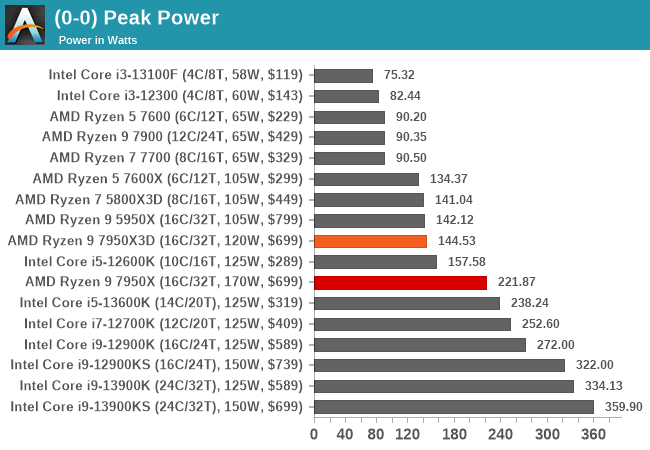
Given that the Ryzen 9 7950X3D has a lower TDP and PPT rating than the Ryzen 9 7950X, it pulls less power. We observed a peak power output of 144.53 W on the 7950X3D, compared to 221.87 W on the 7950X. Talking figures, the Ryzen 7950X3D is pulling around 65% of the power of the 7950X, which is understandable given the power limitations due to the CCX laden with AMD's 3D V-Cache packaging.
Looking at the power consumption of the Ryzen 9 7950X3D in closer detail, we can see that it delivered a consistent load of between 140 and 144 W in our Prime95 sustained power test. This is around 18 Watts lower than the official Package Power Tracking (PPT) level AMD has set at 162 W. However, it operates higher than the TDP of 120 W, which is to be expected. The TDP and PPT ratings are different as the TDP is the base power the CPU should be drawing, while the PPT (socket), set at 162 W, is the maximum the processor can draw as a maximum under full load.
Office/Web
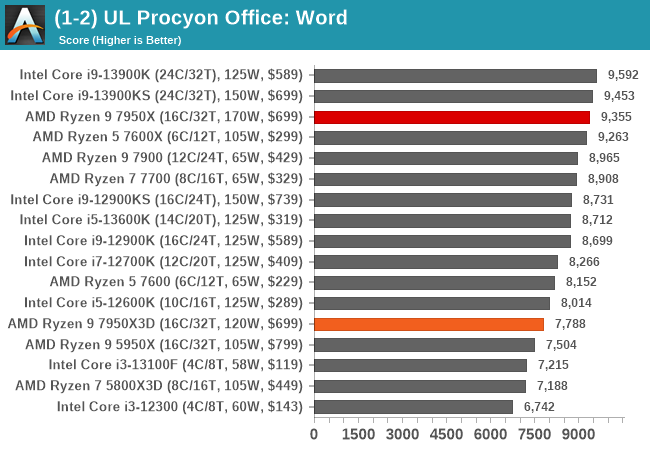
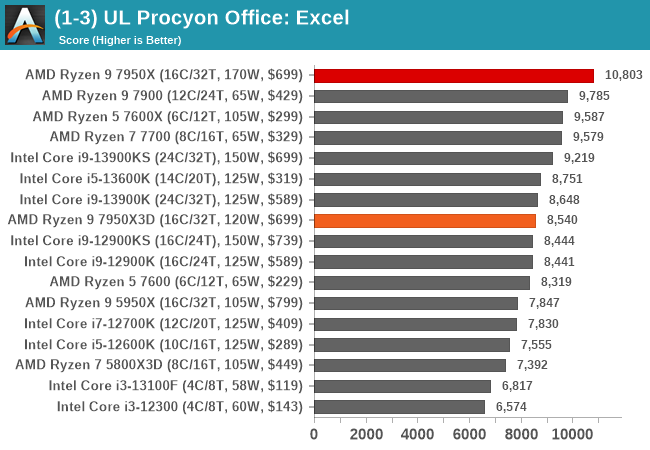
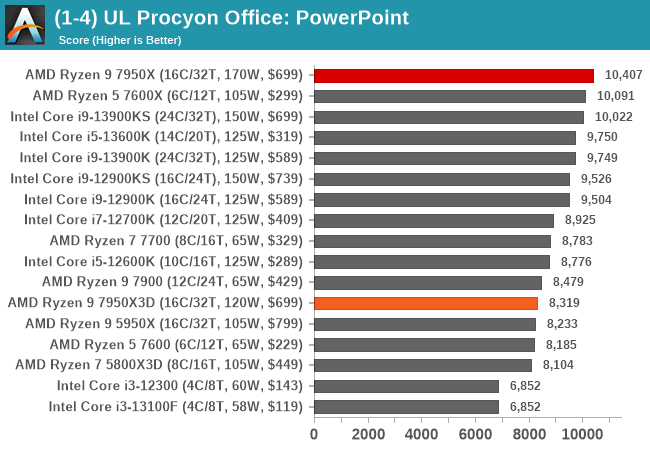
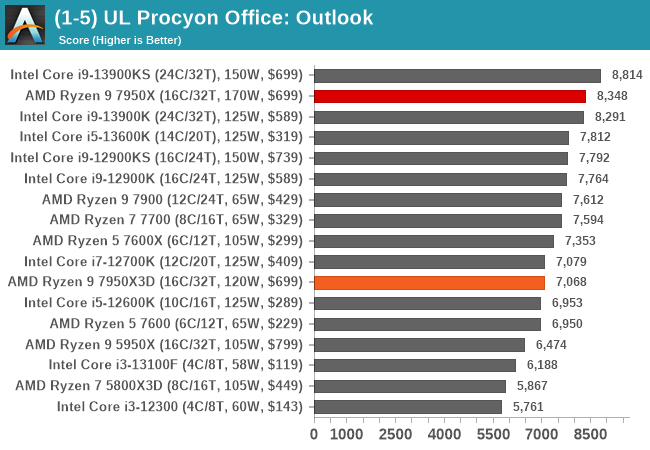
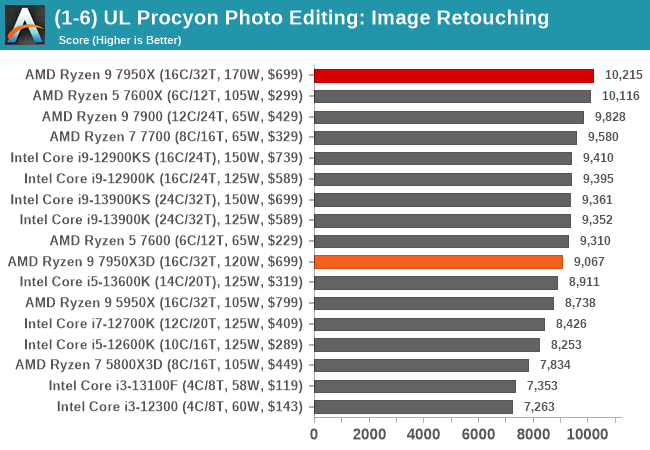
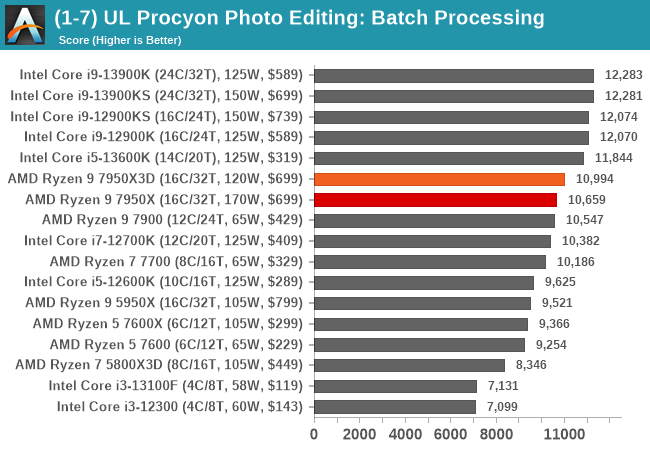
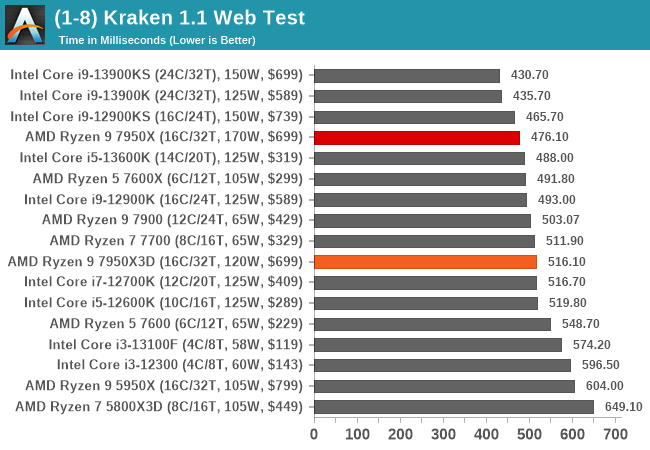
In our office-based testing, the Ryzen 9 7950X3D performs a little worse than the 7950X, but this is to be expected given the differences in TDP, PPT, and the overall power envelope. Still, the 7950X3D performs well and is more than suitable for office and web-based tasks.


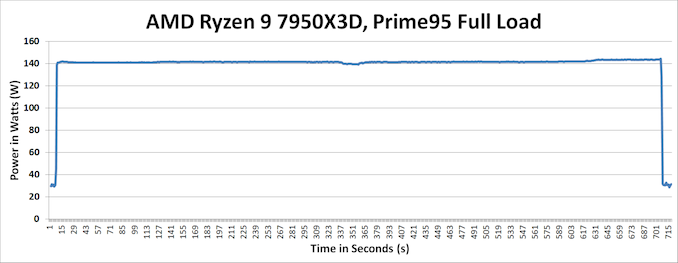








122 Comments
View All Comments
Oxford Guy - Wednesday, March 1, 2023 - link
Has Intel or AMD ever invalidated a warranty for turning on XMP?Please post an article about this to answer that question.
cheshirster - Monday, February 27, 2023 - link
Always has been )They are risking with their "access to the body" by showing AMD on top.
Gastec - Wednesday, March 1, 2023 - link
Well, the world is not feeding trolls as much as it used to do, because of disruptions in the "serials" supply blockchains.HarryVoyager - Monday, February 27, 2023 - link
Definitely looks like AMD is using this as a dry run for their rumored Zen 4c architecture. From the rumors I've seen, they were able to pack about two Zen 4c cores into the space of a standard Zen 4 core by repackaging the logic and removing half the cache. But that means to use them as super E-cores, they need a scheduler that can handle by cache, not frequency like Intel's does.By launching the dual CCD CPUs first, they're able to see and work through those issues now, on a low risk platform before they go full heterogenius. Very shrewd on AMD's part.
nandnandnand - Monday, February 27, 2023 - link
Shrewd, but only if it works in the end. And the buyers of these high-end gaming parts are the beta testers.AvidGamer - Monday, February 27, 2023 - link
That says a lot about the perception and respect AMD has for its ordinary, loyal customers, using them as Beta testers, what a deplorable custom!nandnandnand - Monday, February 27, 2023 - link
It's Alder Lake all over again, but with an apparently dumb method of optimizing for specific programs.We will have to live with it though. big.LITTLE in some form is here to stay over at Intel, and we've seen rumors of Zen 5 + Zen 4C on desktop.
Gastec - Wednesday, March 1, 2023 - link
It's only $700 bucks, come on! Pocket change for successful influencers!AvidGamer - Monday, February 27, 2023 - link
Fully agree with you there! Interesting and thought provoking comment, thanks for sharing your thoughts on this matter! I too believe that some of the practices of AMD are often rather shrewd in their nature...Targon - Tuesday, February 28, 2023 - link
Not even close to what is going on. The 5800X3D was clearly the final chip for socket AM4, and yes, it was primarily focused on gaming since that is where that 3D stacked cache tends to benefit users more.For the Zen4 versions, you will see the 7800X3D, which has one CCD, then the 7900X3D and 7950X3D. For the dual-CCD chips, because GAMES don't use more than eight cores, AMD did the best mix, apply the stacked cache to one CCD, leaving the other CCD without, just so it can be clocked higher. Again, games are pretty much the only chips that show the benefit to the extra cache, so why put the stacked cache on both CCDs?
Zen4c is going to be for servers that will use more cores, but don't need as much cache to operate. When more cores is more important than the very best performance per core, Zen4c makes more sense. There is nothing about stacked cache that applies to Zen4c.
Intel E-cores are pretty much garbage, less functional(they didn't include AVX-512 even when the performance cores did), but more cores DOES benefit certain types of workloads. Note that Intel laptop chips are using this almost to deceive consumers, dual performance core i7s with efficiency cores to make them not as bad will still be worse than any i7 should be. Intel used to sell a lot of low-priced i7 chips with only 2 cores/4 threads, so now, dual-performance cores with some efficiency cores to be not as bad as dual-core i7 chips used to be.
Now, the 7800X3D will be only a single CCD part, so the ONE CCD will have the 3D stacked cache on it. AMD is doing this because the volume of sales for the dual-CCD X3D chips is expected to be fairly low, while the 7800X3D will probably have a very high volume of sales. It's best not to encourage all of the stacked cache modules to go to the 7800X3D where the highest demand will be.